Top Tree Safety Tips for Thunderstorms
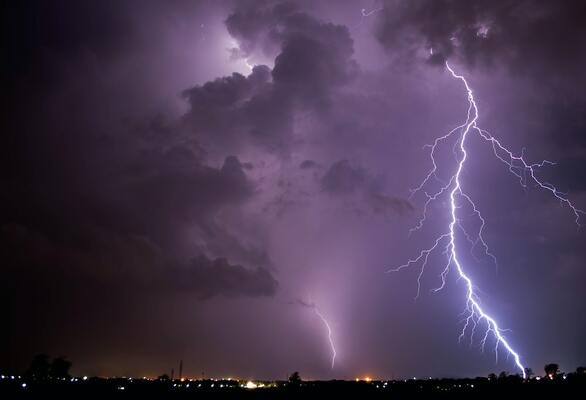
Photo by Amol Mande
Introduction
Thunderstorms can pose a significant threat to the trees in your landscaping. Despite appearing sturdy, trees are often vulnerable to damage during severe storms. The San Francisco Bay Area, with its unique climate and frequent weather changes, requires special consideration when it comes to tree safety. In this comprehensive guide, we'll provide you with essential tree safety tips to ensure your trees remain healthy and resilient even in the face of heavy thunderstorms.
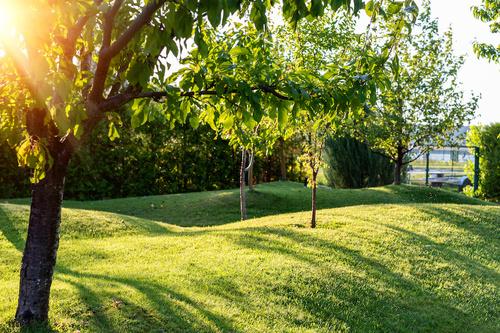
Sunlit Trees on a Green Lawn
San Francisco is known for its diverse urban forest, featuring a wide range of tree species. Some trees are better suited to withstand the specific weather patterns of the region, which can include heavy rains and strong winds during storms.
1. Choose the Right Tree Species
Selecting Suitable Tree Species for Your Region
Living in an area prone to drastic weather changes involves careful consideration when choosing tree species for your landscaping. Some trees are better equipped to handle strong winds and moisture, making them ideal choices for storm-prone regions.
Consider planting species like:
- Austrian Pines: Known for their robust branches and resistance to strong winds.
- Bald Cypress: Naturally adapted to wet conditions, making them ideal for areas with heavy rainfall.
- Red Oak: A sturdy species with deep roots that can withstand storms.
- Red Maple: Resilient against moisture and adaptable to various soil types.
- Linden: Known for its strong branches and resistance to wind.
- Autumn Blaze Maple Trees: Combine the sturdiness of maples with vibrant fall colors.
- Monterey Pine: Native to California, these trees are adapted to coastal conditions and can handle both salt spray and strong winds.
- Coast Live Oak: Known for its robust branches and deep roots, making it resilient against storms.
- California Buckeye: Features striking foliage and is well suited for the Bay Area's climate.
- Blue Palo Verde: A drought-tolerant tree that thrives in the Bay Area's arid regions.
However, the species alone is not enough; maintaining tree health is equally crucial. While the type of tree is important, it’s more important that the trees you have are healthy and well maintained. Keeping your trees properly watered, pruned, and provided with nutrients will help more than anything else when it comes to heavy storms.
2. Maintain Tree Health
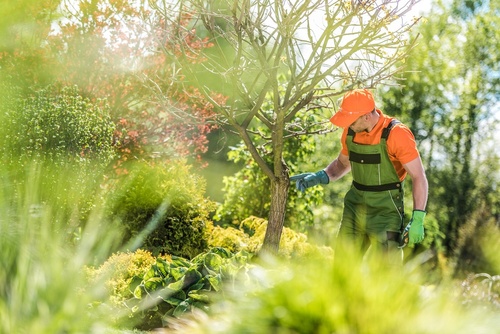
A Worker Tends to a Small Tree in a Garden
Consistent Tree Care
To ensure tree longevity and resilience, you'll want to adopt a proactive approach to tree care.
Establish a regular maintenance routine that includes:
- Watering: Consistent and deep watering is essential for tree health. Ensure that your trees receive adequate moisture, especially during dry spells or after storms.
- Pruning: Regular pruning not only eliminates weak and dying branches but also promotes proper structure and growth, making your trees more resistant to weather-related damage.
- Fertilization: Fertilize your trees as needed to provide essential nutrients for growth and strength.
3. Regular Tree Pruning
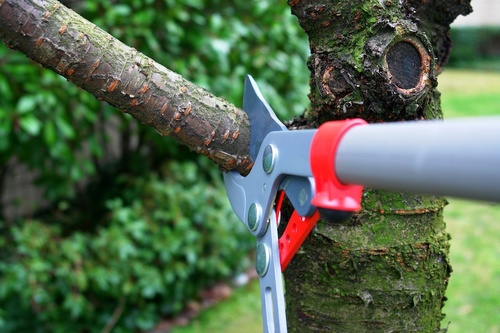
A Small Tree Branch Being Pruned
The Importance of Regular Pruning
Pruning your trees should be an ongoing practice, not just a reaction to damaged or dead branches. Start pruning when trees are young to help them develop strength and withstand storms.
Benefits of regular pruning include:
- Enhanced Structural Integrity: Pruning helps maintain a strong and balanced tree structure, reducing the risk of branches breaking during storms.
- Improved Air Circulation: Properly pruned trees allow for better air circulation, reducing the chances of fungal diseases.
- Promotion of New Growth: Pruning encourages new growth and can rejuvenate older trees.
4. Protect the Tree Roots
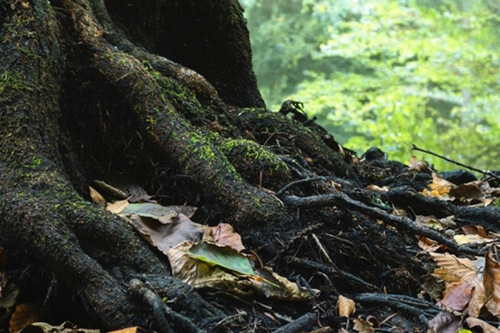
A Cluster of Exposed Tree Roots - Photo by Mali Maeder
Nurturing Strong Roots
Tree roots are the foundation of tree stability, often referred to as the "anchor" of the tree. To keep your tree roots robust, ensure the area around your trees is well mulched. Adequate mulch retains moisture and supplies essential nutrients to sustain tree health.
Additional tips for protecting tree roots include:
- Mulch Depth: Apply mulch to a depth of 2-4 inches, extending out to the tree's drip line but leaving a small gap around the trunk to prevent moisture buildup.
- Avoid Compaction: Prevent soil compaction around the root zone by avoiding heavy foot traffic and machinery in that area.
- Avoid Soil Erosion: Utilize erosion control measures, such as retaining walls or ground covers, to prevent soil erosion around tree roots.
5. Safeguard the Tree Trunk
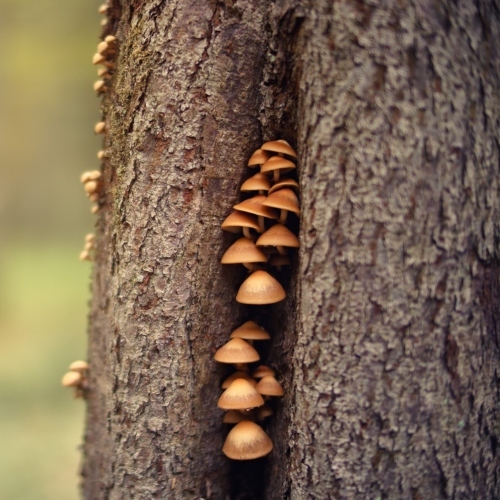
Tiny Mushrooms Line a Groove in a Tree Trunk - Photo by Johannes Plenio
Protecting Tree Trunks from Storm Damage
Prior to an impending storm, take precautions to protect tree trunks.
Consider these steps to safeguard your trees from potential damage:
- Trunk Wrapping: Wrap the trunk in protective material, such as burlap or tree wrap, to shield it from potential damage by flying objects. Make sure to remove these covers once the storm passes.
- Support Systems: Install support systems like tree stakes or cables for larger trees to prevent them from leaning or falling during storms.
6. Monitor for Pests and Diseases
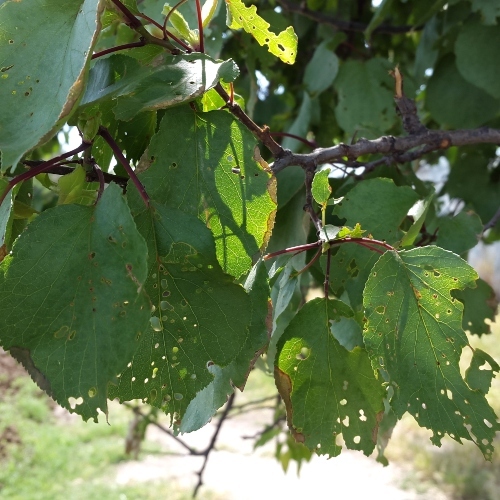
Leaves with Damage from Pests and/or Disease - Photo from Wikimedia Commons
Vigilance Against Pests and Diseases
Regularly inspect your trees for signs of pests or diseases, as weakened trees are more susceptible to storm damage.
Look out for:
- Infestations: Check for insect infestations like aphids or borers that can weaken tree health.
- Fungal Infections: Monitor for fungal diseases like powdery mildew or root rot, which can compromise tree stability.
- Deadwood: Remove dead or decaying branches promptly to prevent them from becoming projectiles during storms.
7. Consult a Certified Arborist

A Lush, Healthy Forest at Sunset
Professional Guidance
For a thorough assessment of your trees and expert advice on tree safety, consider consulting a certified arborist.
They can provide:
- Tree Health Evaluation: An arborist can assess the overall health of your trees and recommend necessary treatments or care.
- Storm Preparedness: Arborists can help you develop a storm preparedness plan specific to your trees and region.
- Emergency Services: In case of storm-related damage, arborists can provide emergency tree care and removal services to mitigate further risks.
8. Soil Testing and Amendments
Soil Health and Tree Resilience
Healthy soil is vital for strong tree growth and resilience during storms.
Consider these soil-related tips:
- Soil Testing: Regular soil testing can identify nutrient deficiencies or imbalances, allowing you to adjust your fertilization strategy accordingly.
- Soil Amendments: Applying organic matter like compost or mulch can improve soil structure, water retention, and nutrient availability for your trees.
9. Windbreak Planting
Strategic Planting for Wind Protection
Create windbreaks by strategically planting sturdy trees or shrubs around your property's perimeter. These windbreaks can shield your trees from strong winds and reduce the risk of storm damage.
10. Storm-Resistant Tree Varieties
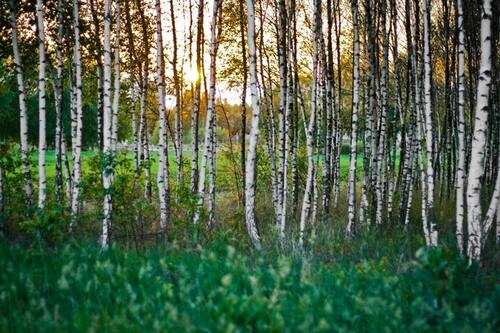
A Line of Storm-Resistant Birch Trees
Opt for Storm-Resistant Tree Varieties
Consider planting tree varieties known for their storm resistance.
Some options include:
- Live Oaks: Known for their resilience to hurricane-force winds.
- River Birch: Can withstand both wet conditions and wind.
- American Holly: Features strong branches and is drought resistant.
- Cedar Elm: Resistant to extreme weather conditions, including drought and storms.
11. Water Management
Proper Drainage and Watering
Effective water management can help prevent soil erosion and root damage during storms.
Consider the following water-related tips:
- Proper Drainage: Ensure that your property has proper drainage systems in place to divert excess water away from tree roots.
- Watering During Droughts: During prolonged droughts, provide supplemental watering to keep your trees hydrated and less susceptible to storm damage.
12. Dos and Don’ts:
In addition to species selection, here are some best practices and dos and don'ts to ensure the safety and health of your trees during thunderstorms:
Dos:
- Do Choose Suitable Tree Species: Select tree species that are native to the region or well suited to the local climate. Consider consulting with a local arborist for expert advice.
- Do Maintain Regular Tree Care: Establish a consistent maintenance routine that includes proper watering, pruning, and fertilization to keep your trees healthy and resilient.
- Do Prune Trees Regularly: Regular pruning is essential for maintaining tree structure and removing weak or dead branches. Start when trees are young to encourage proper growth.
- Do Protect Tree Roots: Mulch the area around your trees to retain moisture and provide essential nutrients to the roots. Avoid compaction and soil erosion around the root zone.
- Do Monitor for Pests and Diseases: Regularly inspect your trees for signs of pests or diseases and take appropriate action to address issues promptly.
- Do Consult a Certified Arborist: Seek professional guidance from a certified arborist for tree health evaluations, storm preparedness plans, and emergency tree care services.
Don'ts:
- Don't Overwater: Avoid overwatering your trees, as this can lead to root rot. Use a deep watering method and adjust watering based on soil moisture levels.
- Don't Neglect Soil Health: Regular soil testing and amendments are essential for strong tree growth. Ensure proper soil drainage and fertility.
- Don't Plant Invasive Species: Avoid planting invasive tree species that can disrupt local ecosystems and harm native vegetation.
- Don't Ignore Storm Warnings: Stay informed about weather forecasts and take proactive measures to protect your trees before storms hit.
- Don't Delay Tree Care: Address tree maintenance and health issues promptly to prevent them from becoming more significant problems during storms.
Conclusion:
We hope these comprehensive tree safety tips help you safeguard your trees during severe storms that your area may face this year. Protecting your trees ensures not only their longevity but also a safer and more beautiful environment for you and your community. Arborist Now can assist you with any additional questions and can do a safety assessment on your trees and landscape. Just reach out to us.
Remember, proactive tree care and preparation are key to minimizing storm-related damage. By choosing the right tree species, maintaining their health, regular pruning, protecting roots and trunks, monitoring for pests and diseases, seeking professional guidance when needed, as well as considering soil health, windbreaks, storm-resistant tree varieties, and proper water management, you can ensure that your trees thrive even in the harshest weather conditions.
Prioritize both your safety and the well-being of your trees, creating a resilient and vibrant landscape that withstands the test of time. By implementing these tips and strategies, you'll not only protect your investment but also contribute to the overall beauty and health of your environment. Your trees will thank you for it, and so will future generations who can enjoy their beauty and benefits.
Originally posted on February 7, 2019





